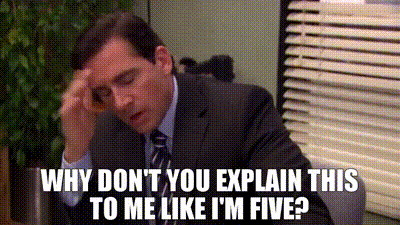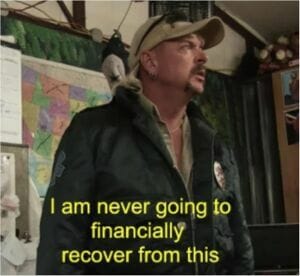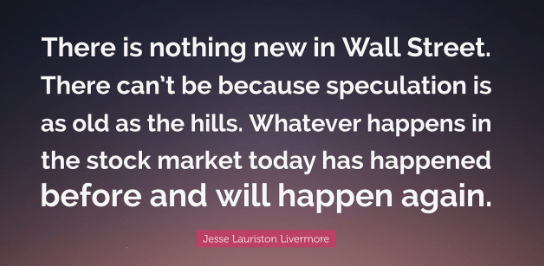- The Antifragilist
- Posts
- Market Crashes, Feds, Interest Rate, and Inflation - Part 1
Market Crashes, Feds, Interest Rate, and Inflation - Part 1
Guten Tag Everyone,
We are the Antifragilist, where we explain things to you like you are a 5-year-old.

This week I will be doing a mini-series on the above topic. Think of it as a Tiger King but for Finance.

Have you been dreading checking your 401K or Investment Portfolio lately? Like so tired of seeing red that you are texting someone with an android phone just to see some green. No matter what asset class you are invested in, the market seems to be in free fall. And everyone says it's because the fed is raising the rates or this or that...Like what does that even mean?
While the market is going down, the grocery bill seems to be going the other way every week. If you are into hurting yourself, try checking your portfolio while paying for your grocery bill on your next Costco trip (highly recommend going today for best bang for the buck). The shit hurts bad.
But this is not the first time the markets are going down nor will be the last. If you don't believe me, see the below quote from one of the greatest traders ever.

If you still don't believe me, below is the list of the greatest historical market crashes recorded:
1792- Alexander Hamilton, the greatest ever (I am a big fan), was a pioneer who helped create the First Federal Bank of United States, literally called BUS (Bank of United States) in 1790 backed by Federal Debt. And of course, what's a bank without a good bail-out. Speculative behavior, fraud, and a cut in the supply of loans led BUS to crash 25% in two weeks (Ouch!!). Hamilton led the first bail-out of an American bank funneling cash to lenders, buying federal debt to keep the prices stable, and ensuring banks with sufficient collateral could borrow as much as they wanted (Is it 2008 again?)
1825 - If you think Latin America is an emerging market right now, think again. Countries like Colombia, Peru, Chile, Mexico, and Guatemala were hot between 1822-1825. Forget crypto, British mining companies planning to explore these countries saw their share price rise from 33 to 158 in a month. Investors, and companies were flocking to invest in the new colonies. The only problem? They were far from western countries. Like months to get there and not much of communication. But as Gordon Gekko said, "Greed is Good". Investors still piled on looking for better returns without much research. Apparently, a guy named Gregor MacGregor created a fake country, made himself its ruler and sold fake government bonds, and land rights (Bernie Madoff has nothing on this guy). And of course the market tanked. For example, Peruvian bonds fell 40% of their face value, with others following suit. British and Wales banks were hit hard with more than 10% of them shut down. Bank of England had to inject funds to lenders and companies directly to save their economy.
1857 - By 1850s, financial crashes had become a norm. European countries were seeing small, manageable crashes almost every decade. But the crash of 1857 dwarfed them all. The reason? lofty valuations, and financial innovation. Railway Companies like Illinois Central, Philadelphia and Reading were the FAANG of 1850s. The money they made didn't justify their valuations. Sounds familiar, right? Similarly, non-railroad companies got caught up in railway fever and invested heavily. Just for some context, Ohio Life Insurance company invested $3m of $4.8m in railway companies. With any leverage and overexposure, there is a price to pay. Apparently, there was one lending house that was supporting 900,000 pounds in loans with only 10,000 pounds of capital (that's 90:1 leverage ratio). By spring of 1857, railroad stocks were in free fall dragging down everything that was invested in it. That includes American Banks, British cities that had an interest in the American economy, etc. An American bank with offices in Liverpool, and Glasgow collapsed taking Western Bank of Scotland with it (Hello Lehman Brothers). 135 bankruptcies were reported in the last three months of 1857 in Britain. The world had experienced its first global financial crash.
1907 - With the failure of BUS (Bank of United States), US moved to a decentralized banking system. This resulted in banks, and more importantly trusts propping up like mushroom. By 1907, America has 22,000 banks, thats 1 for every 4000 people. The problem child, however, were trusts. They were like a pseudo banks that took deposits from its customers but instead invested the funds in riskier assets unlike banks that only invests in safe assets. The trusts were paying much higher interest rates to its depositors attracting more funds. However, every growth opportunity attracts scammers and fraudsters. Two scammers, Augusts Heinze, and Charles Morse had borrowed and embezzled large sums of money from trusts like Knickerbocker Trust to corner copper market. When the copper stock started to go down, the embezzlers were in trouble and started to use the funds from theses trusts. When the news broke out of the trouble, depositors lined up in the trusts office demanding their money. With the requirement of only 5% of assets to be held on cash (traditional bank required 25%), the trust couldn't pay out the money requested by its depositors. Well if this doesn't cause the bank run, don't know what does. Public rushed to their respective trusts to take out their cash with caused a ripple effect as companies weren't able to pay out their depositors. There was blood in the streets. An emergency plan of $500 million was put together to save the economy. Hamilton was right after all.
1929-1934 - The 1920s is my absolute favorite era. The roaring 20s. The era of Jay Gatsy, prohibition, Model Ts, and Jessi Livermore. It was one big party. New homes were built at a record pace, technological innovation was in full swing with radios, aluminum, and airplanes being the most popular and the market was at an all-time high. Well, every party has to end. And, boy did it end. By late 1929, industrial production fell at annualized 45%, banks failed in record numbers. A total of 11,000 banks closed between 1930-1933. The panic wasn't limited to US. Britain, Austria, and Germany were impacted as well. The market lost 25% in two days with more downward spiral to follow. Unemployment topped 25% and wouldn't normalize till the early 1940s. This was The Great Depression. This gave birth to a series of reforms to protect the economy from potential future events. If you have noticed FDIC insured in your local bank, thank The Great Depression. The Federal Deposit Insurance Commission (FDIC) was established on January 1st, 1934 to protect $2,500 of deposits per customer. The current amount is $250,000 per depositor, per insured bank.
I have deliberately left out the crash of 1987, the dot-com burst of 1999-2000, and The Great Recession of 2008-2009. They all follow a similar pattern of speculative behavior fueled by high leverage, and lofty valuations, with scammers thrown in here and there. Every crash and crisis was followed up with a stronger system. Mild recession and crashes are good for the economy as a whole. It makes the system better able to absorb the shocks and ultimately make them anti-fragile. So, don't be as bummed to see the market go down (easier said than done). And, if you have some cash lying around, it might be a good time to put it to use.
One of the crashes listed above has played a pivotal role in where we are at today. I will explain how in our next series. Stay tuned....
Some Book Recommendations
Reminiscences Of a Stock Operator
Manias, Crashes, and Crashes
The Big Short